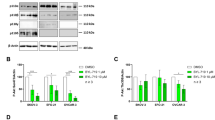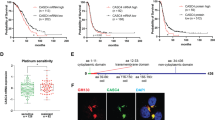Abstract
Aim:
To investigate the effects of S-allylcysteine (SAC), a water-soluble garlic derivative, on human ovarian cancer cells in vitro.
Methods:
Human epithelial ovarian cancer cell line A2780 was tested. Cell proliferation was examined with CCK-8 and colony formation assays. Cell cycle was analyzed with flow cytometry. Cell apoptosis was studied using Hoechst 33258 staining and Annexin V/PI staining with flow cytometry. The migration and invasion of A2780 cells were examined with transwell and wound healing assays. The expression of relevant proteins was detected with Western blot assays.
Results:
SAC (1−100 mmol/L) inhibited the proliferation of A2780 cells in dose- and time-dependent manners (the IC50 value was approximately 25 mmol/L at 48 h, and less than 6.25 mmol/L at 96 h). Furthermore, SAC dose-dependently inhibited the colony formation of A2780 cells. Treatment of A2780 cells with SAC resulted in G1/S phase arrest and induced apoptosis, accompanied by decreased expression of pro-caspase-3, Parp-1 and Bcl-2, and increased expression of active caspase-3 and Bax. SAC treatment significantly reduced the migration of A2780 cells, and markedly decreased the protein expression of Wnt5a, p-AKT and c-Jun, which were the key proteins involved in proliferation and metastasis.
Conclusion:
SAC suppresses proliferation and induces apoptosis in A2780 ovarian cancer cells in vitro.
Similar content being viewed by others
Log in or create a free account to read this content
Gain free access to this article, as well as selected content from this journal and more on nature.com
or
References
Yancik R . Ovarian cancer. Age contrasts in incidence, histology, disease stage at diagnosis, and mortality. Cancer 1993; 71: 517–23.
Pujade-Lauraine E, Wagner U, Aavall-Lundqvist E, Gebski V, Heywood M, Vasey PA, et al. Pegylated liposomal doxorubicin and carboplatin compared with paclitaxel and carboplatin for patients with platinum–sensitive ovarian cancer in late relapse. J Clin Oncol 2010; 28: 3323–3329.
Hamilton CA, Miller A, Miller C, Krivak TC, Farley JH, Chernofsky MR, et al. The impact of disease distribution on survival in patients with stage III epithelial ovarian cancer cytoreduced to microscopic residual: a Gynecologic Oncology Group study. Gynecol Oncol 2011; 122: 521–6.
Nobili S, Lippi D, Witort E, Donnini M, Bausi L, Mini E, et al. Natural compounds for cancer treatment and prevention. Pharmacol Res 2009; 59: 365–78.
Iciek M, Kwiecien I, Wlodek L . Biological properties of garlic and garlic-derived organosulfur compounds. Environ Mol Mutagen 2009; 50: 247–65.
Butt MS, Sultan MT, Iqbal J . Garlic: nature's protection against physiological threats. Crit Rev Food Sci Nutr 2009; 49: 538–51.
Zhou Y, Zhuang W, Hu W, Liu GJ, Wu TX, Wu XT . Consumption of large amounts of Allium vegetables reduces risk for gastric cancer in a meta-analysis. Gastroenterology 2011; 141: 80–9.
Iciek M, Kwiecien I, Chwatko G, Sokolowska-Jezewicz M, Kowalczyk–Pachel D, Rokita H . The effects of garlic-derived sulfur compounds on cell proliferation, caspase 3 activity, thiol levels and anaerobic sulfur metabolism in human hepatoblastoma HepG2 cells. Cell Biochem Funct 2012; 30: 198–204.
Lai KC, Kuo CL, Ho HC, Yang JS, Ma CY, Lu HF, et al. Diallyl sulfide, diallyl disulfide and diallyltrisulfide affect drug resistant gene expression in colo 205 human colon cancer cells in vitro and in vivo. Phytomedicine 2012; 19: 625–30.
Chu Q, Lee DT, Tsao SW, Wang X, Wong YC . S-allylcysteine, a water-soluble garlic derivative, suppresses the growth of a human androgen-independent prostate cancer xenograft, CWR22R, under in vivo conditions. BJU Int 2007; 99: 925–32.
Tanaka S, Haruma K, Yoshihara M, Kajiyama G, Kira K, Amagase H, et al. Aged garlic extract has potential suppressive effect on colorectal adenomas in humans. J Nutr 2006; 136: 821S–826S.
Velmurugan B, Mani A, Nagini S . Combination of S-allylcysteine and lycopene induces apoptosis by modulating Bcl-2, Bax, Bim and caspases during experimental gastric carcinogenesis. Eur J Cancer Prev 2005; 14: 387–93.
Na HK, Kim EH, Choi MA, Park JM, Kim DH, Surh YJ . Diallyltrisulfide induces apoptosis in human breast cancer cells through ROS-mediated activation of JNK and AP-1. Biochem Pharmacol 2012; 84: 1241–50.
Pagliei B, Aquilano K, Baldelli S, Ciriolo MR . Garlic-derived diallyl disulfide modulates peroxisome proliferator activated receptor gamma co-activator 1 alpha in neuroblastoma cells. Biochem Pharmacol 2013; 85: 335–44.
Chu Q, Ling MT, Feng H, Cheung HW, Tsao SW, Wang X, et al. A novel anticancer effect of garlic derivatives: inhibition of cancer cell invasion through restoration of E-cadherin expression. Carcinogenesis 2006; 27: 2180–9.
Ng KT, Guo DY, Cheng Q, Geng W, Ling CC, Li CX, et al. A garlic derivative, S-allylcysteine (SAC), suppresses proliferation and metastasis of hepatocellular carcinoma. PLoS One 2012; 7: e 31655.
Gapter LA, Yuin OZ, Ng KY . S-Allylcysteine reduces breast tumor cell adhesion and invasion. Biochem Biophys Res Commun 2008; 367: 446–51.
Powolny AA, Singh SV . Multitargeted prevention and therapy of cancer by diallyltrisulfide and related Allium vegetable-derived organosulfur compounds. Cancer Lett 2008; 269: 305–14.
Wong WW, Boutros PC, Wasylishen AR, Guckert KD, O'Brien EM, Griffiths R, et al. Characterization of the apoptotic response of human leukemia cells to organosulfur compounds. BMC Cancer 2010; 10: 351.
Bat-chen W, Golan T, Peri I, Ludmer Z, Schwartz B . Allicin purified from fresh garlic cloves induces apoptosis in colon cancer cells via Nrf2. Nutr Cancer 2010; 62: 947–57.
Malki A, El-Saadani M, Sultan AS . Garlic constituent diallyltrisulfide induced apoptosis in MCF7 human breast cancer cells. Cancer Biol Ther 2009; 8: 2175–85.
Llambi F, Green DR . Apoptosis and oncogenesis: give and take in the BCL-2 family. Curr Opin Genet Dev 2011; 21: 12–20.
Reed JC . Proapoptotic multidomain Bcl-2/Bax-family proteins: mechanisms, physiological roles, and therapeutic opportunities. Cell Death Differ 2006; 13: 1378–86.
Peng C, Zhang X, Yu H, Wu D, Zheng J . Wnt5a as a predictor in poor clinical outcome of patients and a mediator in chemoresistance of ovarian cancer. Int J Gynecol Cancer 2011; 21: 280–8.
Kurayoshi M, Oue N, Yamamoto H, Kishida M, Inoue A, Asahara T, et al. Expression of Wnt-5a is correlated with aggressiveness of gastric cancer by stimulating cell migration and invasion. Cancer Res 2006; 66: 10439–48.
Huang CL, Liu D, Nakano J, Ishikawa S, Kontani K, Yokomise H, et al. Wnt5a expression is associated with the tumor proliferation and the stromal vascular endothelial growth factor — an expression in non-small-cell lung cancer. J Clin Oncol 2005; 23: 8765–73.
Zeng ZY, Zhou YH, Zhang WL, Xiong W, Fan SQ, Li XL, et al. Gene expression profiling of nasopharyngeal carcinoma reveals the abnormally regulated Wnt signaling pathway. Hum Pathol 2007; 38: 120–33.
Ripka S, Konig A, Buchholz M, Wagner M, Sipos B, Kloppel G, et al. WNT5A — target of CUTL1 and potent modulator of tumor cell migration and invasion in pancreatic cancer. Carcinogenesis 2007; 28: 1178–87.
Kikuchi A, Yamamoto H, Sato A, Matsumoto S . Wnt5a: its signalling, functions and implication in diseases. ActaPhysiol (Oxf) 2012; 204: 17–33.
Anastas JN, Moon RT . WNT signalling pathways as therapeutic targets in cancer. Nat Rev Cancer 2013; 13: 11–26.
LoPiccolo J, Blumenthal GM, Bernstein WB, Dennis PA . Targeting the PI3K/Akt/mTOR pathway: effective combinations and clinical considerations. Drug Resist Updat 2008; 11: 32–50.
Noori S, Hassan ZM . Tehranolide inhibits proliferation of MCF-7 human breast cancer cells by inducing G0/G1 arrest and apoptosis. Free Radic Biol Med 2012; 52: 1987–99.
Hui L, Pei DS, Zhang QG, Guan QH, Zhang GY . The neuroprotection of insulin on ischemic brain injury in rat hippocampus through negative regulation of JNK signaling pathway by PI3K/Akt activation. Brain Res 2005; 1052: 1–9.
Acknowledgements
This work was supported by the Zhejiang Provincial Program for the Cultivation of High-level Innovative Health talents (2010-190-4) and the Zhejiang Key Laboratory of Diagnosis and Treatment Technology on Thoracic Oncology (Lung and Esophagus) (2012-02).
Author information
Authors and Affiliations
Corresponding authors
Rights and permissions
About this article
Cite this article
Xu, Ys., Feng, Jg., Zhang, D. et al. S-allylcysteine, a garlic derivative, suppresses proliferation and induces apoptosis in human ovarian cancer cells in vitro. Acta Pharmacol Sin 35, 267–274 (2014). https://doi.org/10.1038/aps.2013.176
Received:
Accepted:
Published:
Issue date:
DOI: https://doi.org/10.1038/aps.2013.176
Keywords
This article is cited by
-
S-allylcysteine suppresses ovarian cancer cell proliferation by DNA methylation through DNMT1
Journal of Ovarian Research (2018)
-
Synthesis and in vitro biological evaluation of thiosulfinate derivatives for the treatment of human multidrug-resistant breast cancer
Acta Pharmacologica Sinica (2017)



